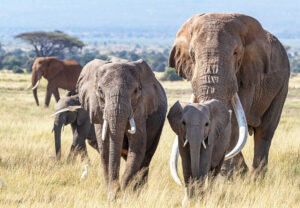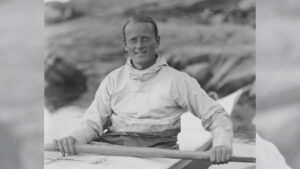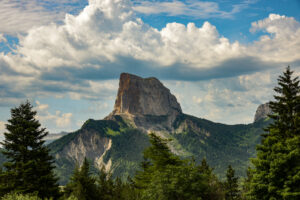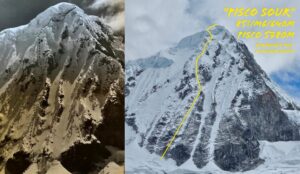The history of Africa’s second-highest peak culminates in the incredible 1943 ascent by escaped prisoners of war using handmade gear and a map sketched on a can of food.
At 5,199m, Mount Kenya is second only to Kilimanjaro (5,895m) among the African giants. It lies just south of the equator, about 150km north-northeast of the capital Nairobi, and gave Kenya its name.

Summit of Mount Kenya. Photo: Wikipedia
A dormant stratovolcano
Formed more than three million years ago, Mount Kenya is an isolated, dormant volcano, unattached to any mountain range. Its last eruption was between 2.6 and 3.1 million years ago. At that time, its crater was over 6,000m high.

The three highest peaks of Mount Kenya. Photo: Adventure Alternativ
Different ethnic groups live around the mountain, among them the Kikuyu, the Embu, the Maasai, and the Ameru. Mount Kenya plays a very important role in their culture. It is thought to be the abode of a god.
Mount Kenya has several peaks. The main peak is Batian (5,199m), followed by Nelion (5,188m), and Point Lenana (4,985m). Other peaks around the central plug of Mount Kenya are Coryndon Peak (4,960m), Point Piggot (4,957m), Point Dutton (4,885m), Point John (4,883m), and several others. All of them reach above 4,600m.

Above: Mount Kenya
Below: Mount Fuji. Mount Kenya once had the same shape as Mount Fuji. Photo: Karisia/Google Earth
The first explorers
The first European to see the mountain was the German missionary, ethnologist, and explorer, Johann Ludwig Krapf. Krapf spotted the mountain from the city of Kitui, 160km east of Nairobi, in 1849. One year earlier, a colleague of Krapf’s first discovered Mount Kilimanjaro.
Krapf thought it would be interesting to find the source of the rivers that came from the direction of the mountain. He believed that the fabled source of the White Nile might be located there. Two years later, Krapf returned and approached Mount Kenya a little more closely but didn’t progress far enough to gain any further information.

Different routes of approach to Mount Kenya. Photo: Adventure Alternative
German botanist Johan Maria Hildebrandt made several trips to Africa in the late 19th century. He visited Eritrea, Yemen, and Somaliland between 1873 and 1874. On January 10, 1877, he traveled to Mount Kenya via Ndara, Ndi, and Kitui. He collected different snails in the area.
His journeys never had an expeditionary objective, only a scientific one. “While these other explorers push restlessly forward and, as it were, do not let the grass grow under their feet, it was my task to collect this very grass,” he said. He recorded and described an extensive list of unknown plants and animals.
Although he heard many stories about the mountain, Hildebrandt never set foot on it. But Mount Kenya had begun to attract the attention of other travelers.

Mount Kenya and its snowy upper slopes. Photo: Equitorialstar
Thomson and the first steps
In 1883, British explorer Joseph Thomson traveled to the area as a member of the Royal Geographical Expedition. They aimed to discover new trading routes in Africa. Thomson confirmed that there was a feasible route in the area.
At the same time, Thomson attempted to climb Mt. Kilimanjaro. He reached the western part of Mount Kenya, climbing it to 1,737m. Although his motto was “He who goes gently, goes safely; he who goes safely, goes far,” he had problems with the local Maasai. In 1887, his book Through Masai Land came out. It was a bestseller at the time.

Nelion and Lewis Glacier. Photo: Wikimedia
Thomson was able to finally confirm one of Krapf’s 1849 observations, that there was snow on Mount Kenya.
Teleki and Hohnel, up to 4,350m
In 1887, Hungarian explorer Samuel Teleki and his companion, Austrian lieutenant Ludwig Ritter von Hohnel, organized an expedition to Africa. The express goal was to climb higher than Thomson.
In February 1887, they left Panganit (Tanzania) and followed the Ruvu River. They managed to climb to 5,310m on Kilimanjaro, where the snow line began. They also reached 4,350m on the southwestern slopes of Mount Kenya, before they turned north to observe the river system.

Lake Rodolphe, later called Lake Turkana, in northwestern Kenya. Photo: The Jakarta Post
On March 5, 1888, they reached “Jade Lake”, now called Lake Turkana. In 1892, they eventually returned to the eastern side of Mount Kenya but could not pass the dense forest they encountered.

The Lewis Glacier on Mount Kenya. The line of flames, made by a torch carried by the photographer during a long exposure, shows the glacier’s reach in 1934. Photo: Simon Norfolk/Institute for The New York Times
Gregory and the geology
Between 1892 and 1893, British geologist John Walter Gregory led another expedition to Mount Kenya and Lake Baringo. Gregory made some important observations about the geology of the mountain. He also attempted to climb it. He managed to pass through the forest zone, reaching the alpine moorland of the glaciers at 4,730m.
In 1894 and 1896, German physician George Kolb also made an expedition to Mount Kenya’s east side and reached those same moorlands.

To climb Mount Kenya is not so easy. Several routes require rock-climbing skills. Photo: Travelmapamundi
Mackinder
In 1899, English geographer Halford John Mackinder led an expedition to the mountain. It proved particularly deadly, with eight of his African porters killed, perhaps by Mackinder himself.
On 30 August, he made a summit push on the southeast face with two of his companions, European guides Cesar Ollier and Josef Brocherel. Just 100m from the summit of Nelion, night fell and they had to retreat. Nearly a week later, on September 5, Ollier, Brocherel, and photographer Campbell Hausberg circled the mountain to find an easier route to the top, but to no avail.
Later, Mackinder, Ollier, and Brocherel climbed the southeast face of Nelion. Finally, on September 13, they also managed to ascend the highest peak, Batian. It marked the first ascent of Mount Kenya.
After this, few expeditions visited Mount Kenya for several years.
Eric Shipton

Eric Shipton. In 1928, when he was 21 years old, he went to Kenya to learn the business of coffee planting.
In the late 1920s, British mountaineer Eric Shipton went to Kenya as a coffee grower. He used his off time to scale several peaks on Mount Kenya. On January 6, 1929, together with Percy Wyn-Harris, he climbed Nelion. Two days later, he climbed the peak again with another companion, G. A. Sommerfelt, and in December he went up again with a third partner, R.E.G Russell.
The group also climbed new peaks on Mount Kenya, including the first ascent of Point John. In late July 1930, Shipton and Bill Tilman completed a traverse via the west ridge of Batian. They then did several more first ascents, to Point Peter, Point Dutton, Midget Peak, and Point Pigott.
A very different climb
All these geographers, geologists, botanists, and explorers organized trips using porters and with significant financing. Their objectives were varied: to search for the origin of rivers, investigate the volcano’s crater, collect new plants, describe new mollusks, find safe trading routes, or scale new peaks. Later, they returned home from their travels to summarize and document their experiences and prepare for new explorations.

Mount Kenya, Batian, and Nelion. Photo: Benefactours
Then in 1943, a very different climb took place, quite unlike any that came before or has happened since. It was art for art’s sake, an escape from miserable reality.
The Prisoner of War
Felice Benuzzi was an Italian mountaineer and diplomat, born in Vienna in 1910 and raised in Trieste, Italy. From a very young age, he climbed in the Julian Alps. He graduated in law at the University of Rome and represented his country in swimming.

Felice Benuzzi. Photo: Wikipedia
At the age of 28, he married Stefania, a young Jewish woman. But shortly after their marriage, new racial laws in Italy declared their marriage illegal. Benuzzi and Stefania left Italy for Africa, where the new law might arrive much later. By 1938, Benuzzi was appointed as a colonial official in Addis Ababa, Ethiopia.
However, Mussolini’s dream of a great African empire was crushed when the British Army moved into East Africa. In 1941, Britain captured Addis Ababa. Benuzzi was sent to Kenya as a prisoner of war. His wife and daughter were detained in Ethiopia.
Camp 354
In East Africa during World War II, there were 24 POW camps, including 19 in Kenya. Each camp was identified by number. Camp 354 was at Nanyuki. Benuzzi was interned there on a rainy day in 1941, joining 1,000 other prisoners.
Life in the camp was boring. Maintaining sanity was a daily struggle. It was worse than jail because they did not know when they would be released.

A letter that one of the prisoners sent from Camp 354. Photo: Militarymail UK
One morning, another prisoner impatiently called Benuzzi over. The clouds lifted and Benuzzi saw “an ethereal mountain emerging from a tossing sea of clouds, framed between two dark barracks: a massive blue-black tooth of sheer rock, inlaid with azure glaciers.
“I stood gazing until the vision disappeared among the shifting cloud banks. For hours afterward, I remained spellbound. I had definitely fallen in love,” Benuzzi later recounted in his mountaineering classic, No Picnic on Mount Kenya.
The plan
It was the first time that Benuzzi had seen such a huge mountain. Benuzzi decided to sneak out of camp and climb Mount Kenya. “To break the monotony, I need only to start taking risks again,” he declared. In 1942, he began to prepare.
In letters to his family, he asked for boots and some warm clothes, without confessing his plan. He stopped smoking so he could save his daily cigarette rations to sell to other prisoners. Gradually, he bought materials to make climbing equipment.

Felice Benuzzi, left, and one of his companions. Photo: Warfarehistorynetwork
He knew that for this adventure, he needed two companions. In the following weeks, he began to observe and assess the other prisoners.
Bunk mate Giovanni Balletto, a doctor and mountaineer, was the first to join him. They had quite a bit of trouble finding a third team member. Finally, Benuzzi decided that instead of looking at the physical abilities of others, he would choose someone he liked. This third man was Vincenzo Barsotti, who had never climbed a single mountain in his life. However, Benuzzi liked Barsotti very much. He seemed just as crazy as Benuzzi was. Barsotti would be in charge of their base camp during the illegal expedition.

Forest and wildlife around Mount Kenya. Photo: Fbatourstravel
Escape
Several other prisoners helped them make crampons, ice axes, clothes, backpacks, ropes, and helmets. They made all these using materials that they found and bought in camp. This creative work was very important for everyone because it also relieved the dullness. They prepared everything by hand, from scratch. They also squirreled away chocolate and other food for the expedition, now scheduled for January 24, 1943.
On that day, they left a note for the camp officer. “Sir,” it said, “we have not previously informed you of our intentions, sure you would try to dissuade us. We are leaving the camp and reckon to be back within fourteen days. Then you will know and certainly approve of our action.”

The English press covered the case of the three fugitive mountaineers.
A very long trek to the foot of the mountain awaited them. They hardly knew anything about Mount Kenya. The only map they had was on a can of food, showing a drawing of Mount Kenya.
Trekking through the forest, they were often scared. There were strange noises at night, and tracks of predators. They felt that they were being watched.
After the forest, they crossed the glaciers and established a base camp at 4,250m. More than a week after their escape, on February 2, they reached the high Hausburg Valley, from where they could closely study Mount Kenya. Their first plan was to climb Batian Peak. Their second option was Punta Lenana.
They were in front of the north face of Batian. Both knew that the peak had already been climbed but they had no idea from which side. They decided to try traversing the northwest ridge. The ridge had only been climbed once, in summer by two exceptional climbers, Shipton and Tilman. In fact, Shipton and Tilman had abandoned the idea to approach the mountain from the northern side and finally attacked it from the south.

Point Lenana, Mount Kenya. Photo: Gigaplaces
The climb
Benuzzi and Balletto started climbing on February 3, 1943. As they had planned all along, Barsetto remained in base camp.
After advancing for more than 15 hours, a major snowstorm began, so they had to turn around and descend. Their meager food ran out. They stumbled into base camp, exhausted, hungry, and despondent. While he waited for them, Barsetto did not want to eat anything out of solidarity, trying to save what little food they had left.

Fixing the Italian flag. Still from the film The Ascent, based on Benuzzi’s adventure.
After a rest day, they decided to climb Lenana. They left base camp on February 6 at 1:50 am. It was much colder than during their attempt on Batian. Despite their simple homemade equipment, they managed to reach the top of Lenana, at 10 am. They put the Italian flag on the top, which they had taken to the mountain in three parts, one man carrying each color. They also deposited an empty brandy bottle on the summit, in which they put a note with their names.
Back to prison
Seventeen days after escaping, they returned to Camp 354. They were willing to face the consequences of their escape. Benuzzi and his two companions did not know that their flag was found on the top of Lenana just a few days later by some British climbers. Already, the story had started to spread. On returning to Camp 354, they were sentenced to remain in isolation cells for 28 days, but the camp commander eventually waived 21 days of the punishment, recognizing their outstanding sporting achievement.
They were repatriated to Italy in 1946. Benuzzi served for many years as a diplomat and eventually died in Rome in 1988.
What about his two companions? In 2017, Benuzzi’s biographer, Wu Ming, described what he knew of them in an interview. Little is known of Vincenzo Barsotti, the non-climber. He became an entrepreneur in East Africa, his company went bankrupt, and he died in the 1980s.
After the war, Giovanni Balletto, the doctor and Benuzzi’s climbing companion on Mount Kenya, had an affair with a local woman. She gave birth to a son named John, who became a safari guide. Balletto committed suicide in 1972, under circumstances never fully clarified.
The saddle between Point Dutton and Petit Gendarme on Mount Kenya is now called Benuzzi Col.

Point Thomson, Batian, Nelion. Mount Kenya. Photo: Wikipedia





